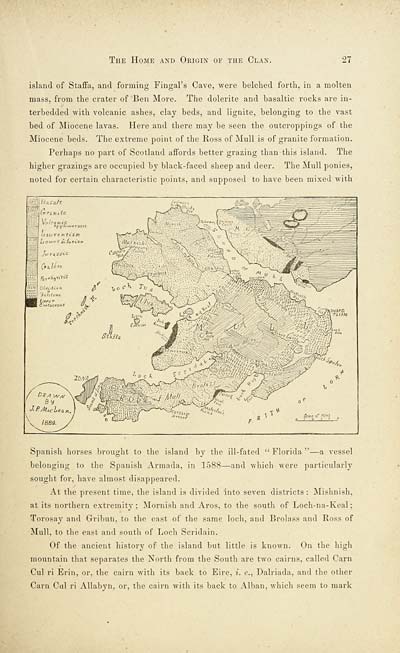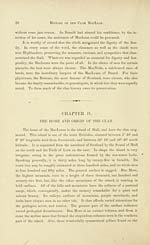History of the Clan MacLean from its first settlement at Duard Castle, in the Isle of Mull, to the present period
(33) Page 27
Download files
Complete book:
Individual page:
Thumbnail gallery: Grid view | List view

The Home and Oriuin of the Clan.
27
island of Staffa, and forming Fingal's Cave, were belched forth, in a molten
mass, from the crater of Ben More. The dolerite and basaltic rocks are in-
terbedded with volcanic ashes, clay beds, and lignite, belonging to the vast
bed of Miocene lavas. Here and there may be seen the outcroppings of the
Miocene beds. The extreme point of the Ross of Mull is of granite formation.
Perhaps no part of Scotland aflbrds better grazing than this island. The
higher grazings are occupied by black-faced sheep and deer. The Mull ponies,
noted for cert;'.in characteristic points, and supposed to have been mixed with
m
... VahaniC
tjowet Si/oTcOti
§1
Spanish horses brought to the island by the ill-fated " Florida " — a vessel
belonging to the Spanish Armada, in 1588 — and which were particularly
sought for, have almost disappeared.
At the present time, the island is divided into seven districts: Mishnish,
at its northern extremity; Mornish and Aros, to the south of Loch-na-Keal ;
Torosay and Gribun, to the east of the same loch, and Brolass and Ross of
Mull, to the east and south of Loch Scridain.
Of the ancient history of the island but little is known. On the high
mountain that separates the North from the South are two cairns, called Carn
Cul ri Erin, or, the cairn with its back to Eire, i. e., Dalriada, and the other
Carn Cal ri Allabyn, or, the cairn with its back to Alban, which seem to mark
27
island of Staffa, and forming Fingal's Cave, were belched forth, in a molten
mass, from the crater of Ben More. The dolerite and basaltic rocks are in-
terbedded with volcanic ashes, clay beds, and lignite, belonging to the vast
bed of Miocene lavas. Here and there may be seen the outcroppings of the
Miocene beds. The extreme point of the Ross of Mull is of granite formation.
Perhaps no part of Scotland aflbrds better grazing than this island. The
higher grazings are occupied by black-faced sheep and deer. The Mull ponies,
noted for cert;'.in characteristic points, and supposed to have been mixed with
m
... VahaniC
tjowet Si/oTcOti
§1
Spanish horses brought to the island by the ill-fated " Florida " — a vessel
belonging to the Spanish Armada, in 1588 — and which were particularly
sought for, have almost disappeared.
At the present time, the island is divided into seven districts: Mishnish,
at its northern extremity; Mornish and Aros, to the south of Loch-na-Keal ;
Torosay and Gribun, to the east of the same loch, and Brolass and Ross of
Mull, to the east and south of Loch Scridain.
Of the ancient history of the island but little is known. On the high
mountain that separates the North from the South are two cairns, called Carn
Cul ri Erin, or, the cairn with its back to Eire, i. e., Dalriada, and the other
Carn Cal ri Allabyn, or, the cairn with its back to Alban, which seem to mark
Set display mode to:
![]() Universal Viewer |
Universal Viewer | ![]() Mirador |
Large image | Transcription
Mirador |
Large image | Transcription
Images and transcriptions on this page, including medium image downloads, may be used under the Creative Commons Attribution 4.0 International Licence unless otherwise stated. ![]()
| Histories of Scottish families > History of the Clan MacLean from its first settlement at Duard Castle, in the Isle of Mull, to the present period > (33) Page 27 |
|---|
| Permanent URL | https://digital.nls.uk/94802279 |
|---|---|
| Description | Illustration: Geological map of Mull |
| Description | A selection of almost 400 printed items relating to the history of Scottish families, mostly dating from the 19th and early 20th centuries. Includes memoirs, genealogies and clan histories, with a few produced by emigrant families. The earliest family history goes back to AD 916. |
|---|

